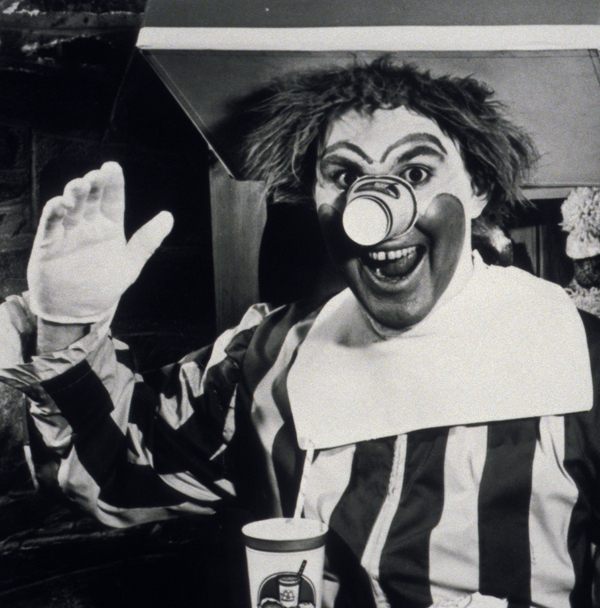What do you do when you capture lightning in a bottle? When you have such a great idea, you’re not quite sure what to do with it, how fast to move, or whether it really will be the success you think it will be?
In my 32 years at McDonald’s, I saw a lot of great concepts and a few not so great. What happened to some of these as we tried to take full advantage of them, when we really had little idea what we were doing? Let’s take a look at both marketing and new products, particular areas I was involved in.
The first time I saw Ronald was in a 1965 commercial introducing him to kids. He had a drink tray for a hat, a drink cup for a nose, and a mouth bigger than Cleveland. And the photography was right out of The Night of the Living Dead. Now, this guy is supposed to appeal to kids?
But he did. It might have taken until 1972 and the advent of McDonaldland to really create the character, but we had a clown by the tail. It took a lot of hard work to define who the character was, how he was supposed to act toward kids, and his role in the total scheme of selling hamburgers. The first Ronald McDonald training clown and I wrote the manual for how to be Ronald on the back porch of his house. Called “Ronald and How,” it endured for decades as the ultimate course on Ronald. He was not to sell to kids; he was to be a kid’s friend, not an adult; and he was to personify fun. We worked really hard to make sure all the Ronalds around the world looked and acted the same, and that’s not easy when you have a six-foot Swede and a somewhat shorter Japanese playing the same part in the same wig and makeup. But we knew we had a winner.
Big ideas have been shaped by need as well as opportunity. Take the Happy Meal. We noticed that moms were buying the kids fries and a drink or a hamburger and a drink, but rarely all three together. Now, we didn’t want to oversell to little kids, but there had to be a way to turn this into a meal rather than a snack. What about a kids meal?
But not just any kids meal, it has to be the McDonald’s way. So a cute cardboard box with games and puzzles, a little packet of McDonaldland cookies, and a Ronald toy later, we had an idea. Package everything with a hamburger, small fries, and a small drink and we have the world’s first Happy Meal. We tried it in St. Louis to substantial success, and the rest is history.
Another historic success was the “Break” campaign. Strategically, we were pretty sure we were on target, but the line “You Deserve a Break Today So Get Up and Get Away to McDonald’s” was way too many words, and took up half the commercial. So it was shortened to “You Deserve a Break Today at McDonald’s.” I guess we were right on, because Advertising Age named it the No. 1 advertising campaign of the 20th century.
Many of our biggest successes with new products were owner-operator ideas. The Big Mac came from Pittsburgh answering the need for a bigger sandwich. The Filet-O-Fish came from the need for a nonmeat sandwich for Catholics on Fridays. And then there’s breakfast.
Breakfast meant a whole new day shift, with new hours, more people needed, obviously a different menu, and the change from a hamburger restaurant to a full-menu restaurant. What a challenge that was. Egg McMuffin is really Eggs Benedict without the sauce, and that was, again, an operator idea. But breakfast is not just one sandwich and coffee. We had to develop a whole new menu, and you know McDonald’s—it had to be unique. I sat in the meeting when the Sausage Biscuit with Egg was first presented. I will never forget the response from our top agency guy: “Let me get this straight. You want me to sell a square egg and round sausage?” Yep!
Then McDonald’s wanted to get into the chicken business, since we saw what was happening with the health trend back then. Chicken, no matter how it was cooked, was seen as healthier than beef. But we couldn’t just do some drumsticks, we had to find a whole new way to eat chicken.
Along came Chicken McNuggets. Bite-sized pieces of chicken that you dipped into great sauces, developed by a real chef. An unanticipated benefit happened almost immediately: Kids jumped all over them. It was really fun to have a finger-food with great-tasting sauces. Nuggets became a kid food, though we fought the idea because we wanted to sell the 20-piece to adults. And everyone copied us.
But not everything is lightning in a bottle. As that health-food trend continued, someone decided we needed a healthy burger. And since fat content is the villain, we reduced the fat in the patty. The McLean Deluxe was born. This one didn’t work, because it was devoid of flavor. No surprise, since hamburger flavor comes from fat. The only way we could sell it was with cheese. So goes reducing the fat. Buh-bye, McLean Deluxe.
A couple of others that didn’t work: pizza and pasta. We had really good products but we learned quickly that people don’t come to McDonald’s for pizza or pasta. We are hamburgers and chicken. Worked in Canada for some reason. So you really can’t be all things to all people.
The moral of the story is that you have to trust your gut. If it feels good, it probably is. Big ideas tend to jump out and show themselves, you just have to weed out the imposters—or pray really hard for luck.
A Peaceful Life full of big ideas that you recognize, and Happy Trails.










